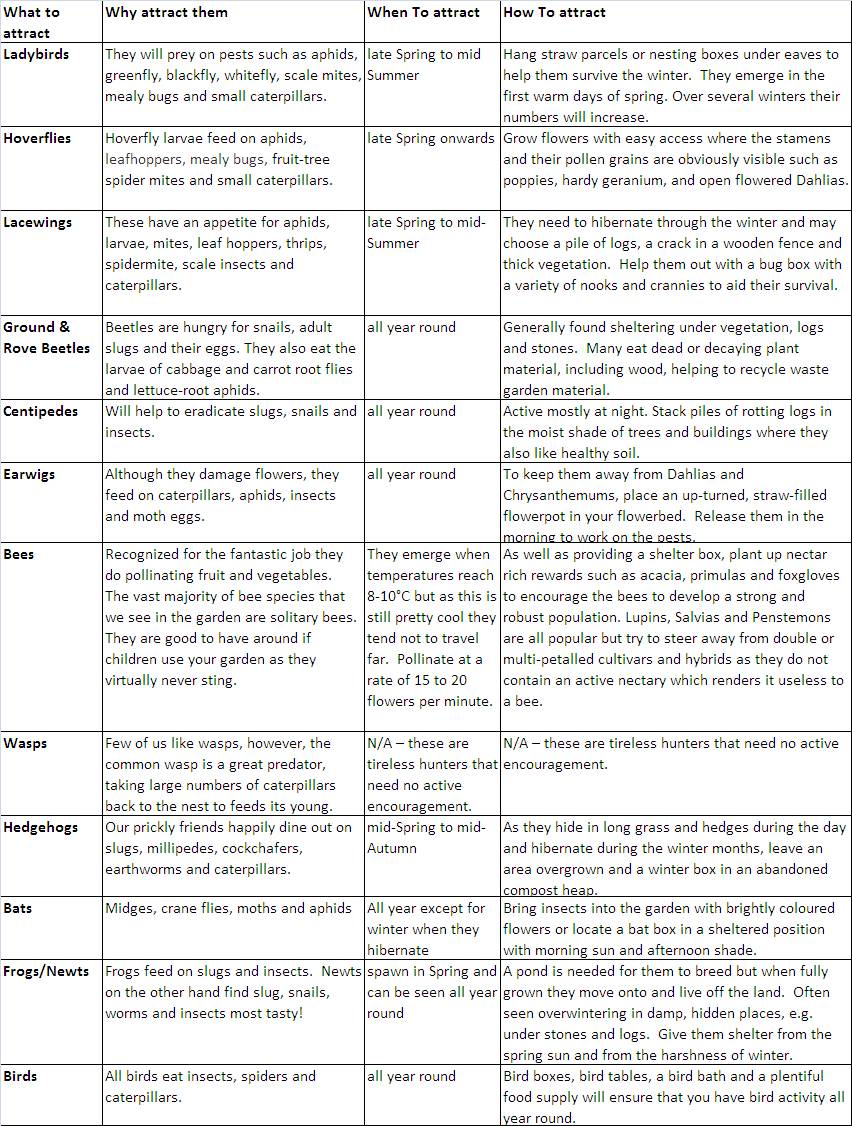Work with Nature
Gardening organically presents the wonderful opportunity to work with nature and to witness its’ amazing recycling chain. Just cast your mind back to those science lessons and the steps in the chain.....
1. Fallen leaves and flowers become decomposed matter which enriches the soil to improve plant growth.
2. The plants that grow provide food for herbivores like slugs, snails and caterpillars – a real frustration for us vegetable gardeners!
3. However, these herbivores in turn provide food for other wildlife like birds, hedgehogs, frogs and ladybirds.
Therefore it makes perfect sense to encourage insects and small animals (natural predators) to establish their homes in your garden by planting suitable plants, giving them shelter and food. Not only will it help to remove pest species in a natural and efficient way but it also maintains the balance of wildlife in the garden environment, making it less likely that any one species will increase enough to overwhelm another or cause problems to crops.
Have a look at this table. It summarises the wildlife that is worth getting to know better. These form the backbone of the useful army of natural predators that will reduce pests to leave you with a harvest of fresh and tasty crops.

Simple Tips for Creating A Natural Habitat
Good news – insects prefer a slightly sloppy garden to a perfectly manicured one! These fun activities are great fun to do with children too (they’re not nearly as squeamish as the adults!) and they get to learn so much at the same time!
- All insects, mammals, amphibians, love to nest and rest so give them a suitable purpose built box.
- Drilling holes in pruned branches and logs provides insects with shelter and nesting space.
- Many beneficial insects overwinter in leaf litter or rotting wood, so creating a small brush pile in one corner of your yard will give them a hand.
- Leaving rotting logs in a corner of your garden can make a home for hedgehogs and insects.
- Wildlife thrives when it isn’t disturbed, so if possible have an area of your garden that you just leave alone - overgrown areas can provide places for animals such as hedgehogs.
- Dense plantings are attractive to many insect species because they protect against wind and rain.
- Many beneficial insects, including predatory ground beetles, like to hide under stones, bricks, or fallen logs, or in compost piles.
- A few beneficial insects, especially frogs, toads and beetles are semi-aquatic. A small water garden will attract them, and also provides a good source of water for other insects and birds. Key tips here are to locate it in an open sunny space, to have shallow edges that allow creatures to climb in and out as well as having minimum depth in one place of 60cm.
- These days you can get glass fronted boxes, hidden camera’s or even solar lighted insect theatres so you can observe at close hand the activities, life cycles and habitats of the insect world.
Why Plant Flowers and Which Ones?
By choosing a wide range of native wild flowers (see recommended list below) you have a greater chance of attracting different kinds of insects who will find food and a home. This is important as a healthy population of pollinators such as lacewings, wasps, hoverflies and of course bees can increase the productivity of your garden by 30%. Many of the insects which you will utilize don't actually do any control work themselves. They spend their lives enjoying the nectar and pollen from your flowers, and creating offspring. It is the larvae stage of these offspring which does the actual hunting and eating of the harmful insects.
Plants which attract and provide homes for beneficial insects include:
- Alyssum
- Aster
- Caraway
- Coriander
- Cornflower
- Dill
- Fennel
- Field Poppy
- Marigolds
- Nasturtiums
- Thyme
- Yarrow
























